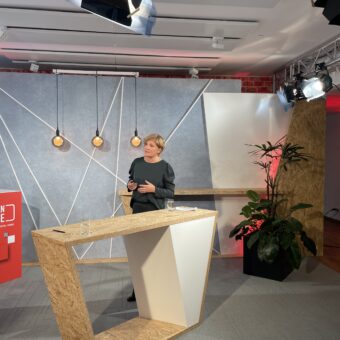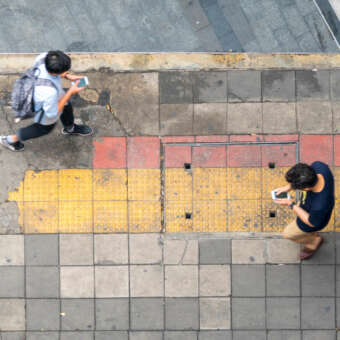“Outdoor-Bekleidung wird eine Art Rüstung”
Diplom-Psychologin Birgit Langebartels vom rheingold Institut in Köln über die aktuelle Stimmungslage der Verbraucherinnen und Verbraucher in Deutschland, wie Marken darauf reagieren sollten und warum der Trend zur Natur ungebrochen ist.
Das Interview erschien am 29. November 2022 in der TextilWirtschaft.
‘Wir legen die Menschen in Deutschland auf die Couch’, so beschreibt Ihr Institut seine Arbeitsweise. Gerade haben Sie eine neue Studie veröffentlicht. Wie ist die Stimmung – vor allem vor dem Hintergrund des Krieges in der Ukraine – derzeit auf den Sofas in deutschen Wohnzimmern?
Wir wollten eigentlich Anfang 2022 mit einer neuen Studie zum Thema ‘Wie geht es den Menschen nach zwei Jahren Corona?’ rausgehen. Unsere Vorstellung war, alle stehen in den Startlöchern und wollen konsumieren, wollen raus, wollen Freunde treffen. Aber die Menschen waren eher melancholisch, schwermütig. ‘Sich jetzt verabreden oder dieses Jahr endlich den Geburtstag groß feiern, ich weiß nicht’, war oft zu hören. Die Menschen betrieben so etwas wie Enttäuschungsprophylaxe. Und dann brach der Krieg aus und wir haben die Studie um die Fragestellung ‘Wie erleben die Menschen den Krieg?’ erweitert.
Mit welchem Ergebnis?
Die Menschen gerieten in so etwas wie eine Schockstarre. Dass ein Krieg so nah rückt und in Europa stattfindet, damit hat keiner gerechnet. Es gab sehr viele Solidaritätsbekundungen, in ganz unterschiedlicher Form. Hier in Köln wurde beispielsweise der Rosenmontagszug gecancelt und in eine Friedensdemo umgewidmet. Dieses Miteinander hat den Menschen geholfen.
Aber eine solche Schockstarre lässt sich letztendlich psychologisch nicht aufrechterhalten. Wir müssen ja irgendwie auch funktionieren. Bei unserer Befragung im Mai haben wir dann gesehen, dass versucht wurde, den Krieg weitestgehend auszublenden. Die Menschen beschrieben, dass sie viel, viel weniger Nachrichten konsumiert haben, dass sie mitunter einen regelrechten Nachrichten-Stopp betrieben und das Kriegsgeschehen kaum noch verfolgt haben. Aber wir wissen natürlich auch – nicht nur als Psychologen – dass das, was wir verdrängen, nicht weg ist, sondern weiterwirkt. So war das auch mit dem Versuch, den Krieg zu verdrängen. Wir haben dies in dem Begriff ‘Kriegstinnitus’ gefasst. Der Krieg wurde zwar verdrängt, war aber trotzdem mal mehr mal weniger spürbar.
Im Sommer konnte man aber schon das Gefühl bekommen, dass der Krieg gar nicht mehr stattfindet…
Das stimmt. Das war eigentlich so die Sommerpause der Probleme. Viele haben ihre Feiern nachgeholt. Runde Geburtstage, die längst nicht mehr rund waren, wurden nachgefeiert. Wir sind in Urlaub gefahren, wir haben das schöne Wetter genossen. Aber wir haben irgendwie schon geahnt, Herbst und Winter werden nicht ganz so gemütlich. Allerdings haben wir bei unserem letzten Update im September gesehen, dass die ganze Krise mit Inflation, Energiekrise längst nicht in allen Haushalten angekommen ist.
Die Stimmung ist also aktuell besser als erwartet?
Wir dachten eigentlich schon, dass die Menschen viel mehr ringen mit der aktuellen Situation, aber das ist längst nicht in jedem Haushalt so. Was aber alle beschreiben, ist das Erleben von etwas sehr Unbestimmtem. Wir nennen es das Gespenst des Vagen. Es ist eine Krise mit ungewissem Ausmaß und ungewisser Dauer. Wie stark die Krise uns letztlich trifft, lässt sich kaum sagen. Ist es nur so, dass ich mir vielleicht einen warmen Pullover anziehen muss? Oder bricht im Winter die ganze Wirtschaft zusammen? Kommt es zu einem Blackout? Reichen die Entlastungspakete? Wie stark steigt meine Stromrechnung? Angesichts dieser Ungewissheit haben wir viel weniger in der Hand, dagegen etwas auszurichten. Und dieses Unbestimmte ist auf verschiedenen Ebenen zu spüren, das birgt ein sehr großes Angstpotenzial.
Was bedeutet das für das Konsumverhalten?
Es zeichnet sich schon jetzt eine Spaltung der Gesellschaft ab, weil die Menschen unterschiedlich stark betroffen sind. Haushalte, die schon zuvor fast an oder sogar unter der Existenzgrenze gewesen sind, die erleben sich im Moment in einer existenziellen Sackgasse. Sie können überhaupt nicht mehr sparen und für sie ist diese Mehrbelastung eine enorme Bedrohung. Andere müssen sich schon sehr stark in ihrem Alltag einschränken und haben große Abstiegsängste. Für eine weitere Gruppe in der Bevölkerung ist es eher so eine unbestimmte Drohkulisse. Die sparen zwar, müssten aber letztendlich nicht wirklich sparen. Aber dieses Sparen hilft ihnen dabei, weil sie das Gefühl bekommen ‚Ich kann etwas ausrichten gegen die Krise, ich kann mich solidarisch zeigen‘. Und dann haben wir aber auch noch den Teil der Bevölkerung, der sich im Grunde das Sparen sparen kann, weil er so gut situiert ist. Wir sehen hier in der Bevölkerung vier unterschiedliche Ausprägungen der Krisenwahrnehmung. Im Vergleich zur Corona-Pandemie ist das ein großer Unterschied, da herrschte das Gefühl vor, dass alle in einem Boot sitzen.
Was bedeutet diese Differenzierung für Unternehmen?
Sparen hat in jedem Fall eine stabilisierende und damit wichtige psychologische Bedeutung. In jedem Fall sind Einkaufsroutinen gestört. In diesem Zusammenhang müssen sich Unternehmen und Marken die Frage stellen, wie sie agieren, wenn Menschen weniger ausgeben, sie aber auch genauer überlegen, wofür sie ihr Geld ausgeben.
Inwieweit sollen Unternehmen und Marken das Thema in ihrer Kommunikation aufgreifen?
Es darf nicht vergessen werden, dass auch die Menschen, die nicht wirklich sparen müssen, die Krisenpermanenz spüren und dadurch auch aus dem Tritt und verunsichert sind. Wenn Marken oder Hersteller hierauf überhaupt nicht antworten, ist das meines Erachtens ein ganz großer Fehler. Marken dürfen jetzt nicht abtauchen, sie müssen präsent sein. Es ist wichtig, dass Marken in ihrer Kommunikation darauf eingehen, allerdings natürlich mit einer positiven Ausrichtung. Im Grunde müssen Marken implizit kommunizieren ‚Wie kann ich dir helfen, durch die Krise zu kommen?‘ Wir haben verschiedene Empfehlungen für die Kommunikation herausgearbeitet. Marken und Hersteller können Übergangshelfer sein.
“Es ist eine Krise mit ungewissem Ausmaß und ungewisser Dauer.”
Birgit Langebartels
Was heißt das konkret?
Präsenz ist wichtig und dass Verbraucherinnen und Verbraucher eine Verlässlichkeit spüren à la ‘Meine Marke lässt mich auch in diesen Zeiten nicht allein’. Transparenz ist wichtig, dass gezeigt wird, wie geht die Marke, der Hersteller in diesen Krisenzeiten mit den Schwierigkeiten um. Wenn wir Marken beraten, schauen wir uns genau die Alltagswirklichkeit der Menschen an. Marken und Produkte haben unterschiedliche Funktionen für die Verbraucher. Manche sind eher alltagsbegleitend, andere – dazu gehört auch Mode – helfen, in eine andere Stimmung zu kommen. Das sind eher psychologische Stimmungswandler. Unternehmen müssen genau herausarbeiten, welches psychologische Feld sie bedienen. Daraus leitet sich dann ab, was die Konsumenten erwarten.
Welche Botschaften sind in der Kommunikation von Marken zu Verbrauchern derzeit besonders wichtig?
Wir sehen da drei große Themenblöcke: Erhalten, Stabilisieren und Mut machen. Eine erhaltende Botschaft bezieht sich eher auf das Vergangene. Sie vermittelt den Menschen, ‘Du musst nicht alles verlieren, was dir lieb und teuer ist’. Etwas bleibt konstant. Das ist beispielsweise Persil mit der 30 Grad-Kampagne gut gelungen. Die Botschaft ist, auch bei 30 Grad wird die Wäsche sauber. Es wird etwas verändert, aber gleichzeitig wird etwas erhalten. Und das stabilisiert die Menschen und legitimiert gleichzeitig, dieses Produkt weiter zu verwenden bzw. letztendlich die Maschine anzustellen und Energie zu verbrauchen.
Hier knüpft dann auch der stabilisierende Aspekt an. Die Botschaft muss sein, ‘wir können Dir helfen, Dich in deinem Alltag so zu stabilisieren, dass Du wieder Fuß fasst’. Die Substanz bleibt auch in der Krise erhalten. Wir merken zum Beispiel, dass viele jetzt bei Butter, Kaffee oder Nudeln auf Eigenmarken zurückgreifen.
Andere Marken ermöglichen es, eine bestimmte Verfassung zu erhalten. Beispiel Ristorante-Pizza. Wenn Menschen jetzt weniger Essen gehen können, können sie sich mit dieser Pizza zu Hause so etwas wie eine Restaurant-Verfassung herstellen und sich so das Gefühl erhalten, ‘ich tu mir etwas Gutes’. Die aktuellen Untersuchungen zeigen ganz deutlich, dass es den Menschen sehr wichtig ist, in ihrem Alltag kleine Oasen, kleine Wohlfühlmomente zu erhalten, wenn große Ausgaben wie Urlaub, Ausgehen, Kultur nicht mehr möglich sind.
Es heißt ja immer, eine Krise ist auch eine Chance. Sehen Sie die für Marken aktuell auch?
Es mag sich paradox anhören, aber auf alle Fälle gilt das jetzt auch. In der aktuellen Situation stellen die Menschen alles auf den Prüfstand. Jetzt mit einer klaren Botschaft aufzutreten, ist eine enorme Chance für die Marke. Es wird neu sortiert. Die Menschen beschäftigen sich mit Fragen wie ‘Was möchte ich mir wirklich für meinen Alltag erhalten?’ ‘Wovon nehme ich Abschied?’ ‘Was tut mir gut, was tut mir nicht so gut?’. Hier müssen sich Marken zeigen und Lösungsangebote für die Krise machen. Der größte Fehler wäre es meines Erachtens, von der Bildfläche zu verschwinden, nicht zu kommunizieren oder aber weiterzumachen wie bisher. Denn es hat sich wirklich etwas geändert. Und das ist es auch, was uns Verbraucherinnen und Verbraucher in den Interviews spiegeln, dass sie sagen: ‘Ja, ich schränke mich ein, für mich hat sich mein Alltag verändert, die Krise schüttelt mich durch. Aber was tun denn die Marken?’
Was sollten sie tun?
Das Signal senden ‘Wir sehen Eure Not, wir sehen, dass Ihr Euch verändern müsst’. Und dabei zu zeigen, was sie selbst gemacht haben und zu vermitteln, was sie tun, um gut durch diese Zeit zu kommen. Das ist wieder der Aspekt des Stabilisierens. Schon in der Corona-Zeit hat sich stark gezeigt, dass die Rückgewinnung von Selbstwirksamkeit und Kontrolle ungemein wichtig ist. Baumärkte wurden gestürmt und es wurde gewerkelt, gebaut, gegärtnert. Es wurde das Gefühl vermittelt, ‘Du kannst selbst etwas schaffen’. Und am Ende des Tages, am Ende der Woche nach dem Wochenende, kannst du wirklich mit Stolz auf ein Werk zurückschauen.
Also Mut für Neues machen?
Einen positiven Zukunftsausblick können wir alle gebrauchen. Es muss vermittelt werden, die Krise hat einen Anfang, aber sie hat auch irgendwann ein Ende. Auch wenn wir das im Moment gar nicht so richtig glauben mögen. Eine Krise hat auch dann ein Ende, wenn wir einen anderen Umgang damit gelernt haben. Oftmals wird in diesem Zusammenhang auch der Begriff der Resilienz genannt. Resilient zu sein, heißt aber nicht, dass alles immer einfach ist, sondern dass ein Umgang mit schwierigen Situationen gelernt wird. Marken und Hersteller können eine solche Zukunftszuversicht transportieren. Beispiel H&M. Das Unternehmen wirbt mit ‘Let‘s change for tomorrow’. Das ist ein positiver Blick in die Zukunft. Marken wie Nivea, Dr.Oetker und Käptn Iglo haben schon viele Jahrzehnte und Krisen überdauert, sind dabei ihrem Markenkern aber treu geblieben und haben immer wieder die jeweiligen Verhältnisse der Gesellschaft adaptiert. Das vermittelt Festigkeit.
Gilt das auch für Sport- und Outdoor-Marken, die Menschen besonders über Erlebnisse und Emotionen packen können?
In jedem Fall. Gerade in der Coronazeit haben wir das gesehen. Draußen wurde zum besseren Drinnen. Draußen war die Ansteckungsgefahr nicht so groß und gleichzeitig haben Outdoortätigkeiten geholfen, die eigene Selbstwirksamkeit zu spüren. Das hat die Menschen für den anstrengenden Alltag gestärkt. Die Outdoor-Bekleidung wird dabei auch als eine Art Rüstung wahrgenommen. Generell ist es spannend, wie Kleidung das Gefühl verändert. Wir hören in den Interviews immer wieder ‘Wenn ich dieses Kleidungsstück anhabe, hilft es mir, zu einer bestimmten Person zu werden’.
Die Outdoorjacke hilft also, zum Naturfreund und Wanderer zu werden?
Nicht nur das. Eine Wanderung ist meist eine gewisse Anstrengung, die sich aber lohnt. Denn man kehrt ein Stück verändert wieder zurück in den Alltag mit dem guten Gefühl, etwas geschafft zu haben und etwas stärker geworden zu sein. Die Menschen beschreiben uns immer wieder diese heilende Wirkung der Ausflüge in die Natur, sich selbst zu spüren, den Regen auf der Haut zu spüren, sich den Wind um die Nase wehen zu lassen, selber etwas zu bezwingen, selber etwas zu schaffen. Und das wird meines Erachtens bleiben, nicht zuletzt, weil der Krisenmodus anhält. Also damit werden wir uns immer wieder ein Stück Selbstwirksamkeit zurückholen können. Und die Menschen haben auch gemerkt, Erholung liegt direkt vor der Haustür, ein Urlaub ganz nah sozusagen.
Welche Marken aus dem Outdoor-Bereich bespielen dieses Thema Ihrer Meinung nach gut?
Einigen Marken in dem Bereich gelingt es momentan gut, das Thema Nachhaltigkeit weit nach vorne zu bringen, beispielsweise Patagonia: Die Verbraucher und Verbraucherinnen erleben es auch als Entgegenkommen der Marke, dass sie selber etwas für die Umwelt tut. Auch das Angebot, Kleidung zu reparieren, wird als zeitgemäßes Entgegenkommen wahrgenommen.
Speziell die Outdoor-Branche ist engagiert in Sachen Nachhaltigkeit. Welche Rolle spielt das Thema bei den Menschen in der aktuellen Situation?
Dieses positive Naturerlebnis ist natürlich sehr eng verknüpft mit dem Thema Nachhaltigkeit. Darin steckt das Erhalten der Natur und damit auch etwas Stabilisierendes. Beim Thema Outdoor sehen wir alle drei Aspekte, die momentan für die Menschen so wichtig sind: Das Bewahrende, das Stabilisierende und das Mutmachende.
Das Interview führte Aziza Freutel.
Birgit Langebartels, Diplom-Psychologin, ist Account-Managerin und Leiterin des Bereichs Gender & Generation. Ihr Forschungs-Schwerpunkt liegt bei Frauen, Kinder und Jugend, gesellschaftlichen Trends und Entwicklungen sowie Gesundheit.
Tel.: +49 221-912 777-14
E-Mail: langebartels@rheingold-online.de





